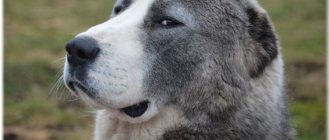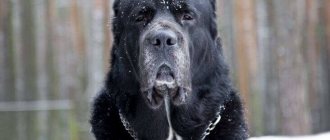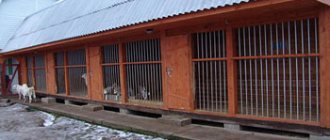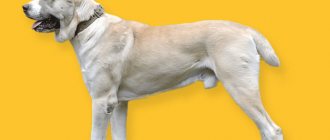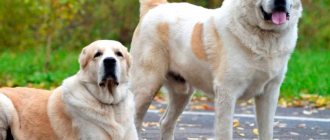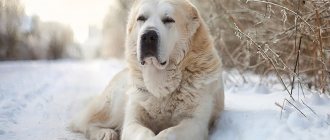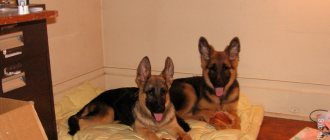| Type |
|
| Size | large (26-50kg) |
| Main features |
|
| Included in |
|
| Intelligence | 50% |
Video
The giant Alabai dog, another name for the breed - the Central Asian Shepherd Dog, cannot be confused with anyone, it amazes with its power and strength. Everything about her is strong and solid, including her character, which is confident and independent. This is an excellent watchman and an unrivaled bodyguard.
Dog experts claim that the Alabai breed has many advantages. They are naturally calm and good-natured. But many are afraid of Central Asian Shepherds as military weapons, and see only disadvantages in the huge dogs. They say that these are dangerous animals that have no place among people, especially on city streets.
Let's figure out what kind of dog the Central Asian Shepherd is and why it causes so much controversy. What is the character of a real Alabai, how to raise him - read about this and more below.
Alabai food
In the photo Alabai mother with children
The Central Asian Shepherd requires a balanced diet with the required amount of vitamins and minerals.
The main rules for proper feeding of Alabai are as follows:
- The presence of two bowls (enamel or aluminum) - with clean water and for food;
- The bowls are placed on a special stand where the height is adjusted. He should reach up to eat food, and not lower his head down;
- Dry food or natural food is only high-quality and fresh, food at room temperature;
- Alabai should always and at any time have access to a bowl of water;
- Feed at the same time. If you haven’t finished eating, the bowl of food is removed; do not allow yourself to overeat;
- Do not give tubular bones or sweets.
Basic rules for proper nutrition in Alabai:
- Since pork fat is poorly absorbed, it is not recommended to give pork;
- The best meats to give Alabai are veal and beef. Give chicken with caution - watch for allergies and avoid the inclusion of tubular bones;
- You can replace part of the meat with offal, but do not exclude meat completely;
- Alabayas often cook soup - first the meat is boiled, then cereal is added to it and left to cook until half cooked. She should not eat more than two liters at a time;
- The diet includes sea fish;
- Cereals - rice, buckwheat and oatmeal;
- If there is a need to switch to a new food, then this must be done gradually, adding new food daily for 6-8 days;
- Fermented milk and dairy products, cottage cheese, and eggs must be included in the diet.
History of the Alabai breed, or Central Asian Shepherd Dog
The Alabai breed is not the product of breeders and amateur dog breeders, it is the result of folk selection. Huge dogs appeared next to humans about 6 thousand years ago. This is what archaeologists say, who discovered miniature figurines depicting dogs with cropped ears and tails during excavations of Bronze Age settlements. Surprisingly, one of the very first breeds has retained its appearance almost unchanged to this day.
This breed has many names. The most popular is alabai, the word is translated from the Turkic language as “spotted dog”. In Kazakhstan they are called tobet, in Uzbekistan - buribasar, which means “wolfhound”, and sarkandzhik - in Kyrgyzstan. And the generally accepted name, which is indicated in the international breed standard, is the Central Asian Shepherd Dog.
The official name of the dog breed, the Central Asian Shepherd, appeared due to the geography of its distribution. The dog was formed over a vast territory - from the Caspian Sea to the Southern Urals. According to some reports, the ancestors of the Alabai were Tibetan mastiffs , to which the blood of various herding dogs was added.
Ancient Central Asian shepherd dogs served as guards for livestock, protected homes and accompanied caravans. These were hardy and seasoned dogs who were not afraid of frost and heat, could fight wild predators, and run great distances. Their descendants inherited from their ancestors a fearless character and the ability to adapt to the harshest conditions.
For a long time, alabai remained assistants to shepherds and shepherds in the countries of Central Asia. Outside these states, giant dogs were known only from the words of travelers. The impetus for professional breeding of the breed was given by Soviet dog handlers. They planned to use the fearsome dogs as guards. They did not change anything in appearance; the dogs were already strong and strong. But certain difficulties arose with the character. It turned out that Central Asian giants are much less trainable than German and Caucasian shepherd dogs, which are accustomed to guard duty. Asians are more stubborn and headstrong; they do not always follow commands and do not obey just anyone.
In Turkmenistan, these dogs are recognized as a national treasure; they are even prohibited from being taken out of the country. They have adopted their own national breed standard and call it the Turkmen Alabai. The head of Turkmenistan presented such a puppy to Russian President Putin in honor of his anniversary in 2022.
The Second World War stopped the popularization of the breed. But in the second half of the 20th century, huge dogs again became of interest to professionals and amateurs. In 1989, the first international standard for the Central Asian Shepherd Dog breed was adopted. The FCI document was assigned No. 335. The latest changes were made there in 2009.
Alabai dog breed: historical facts
Previously, the ancestors of the Alabais competed in tournaments. According to historical sources, Alexander the Great took Central Asian shepherd dogs with him on his campaigns of conquest. The dogs served him faithfully, causing considerable damage to his enemies.
Looking at ancient images of representatives of this breed, you can see the resemblance to mastiffs. They had the same large head, short muzzle, folds on the foreheads, thick dewlap on the neck, and coarse fur. The predominant colors were grey, black and black and tan. The dogs were distinguished by great strength, so they were used to protect noble people.
However, there are no exact historical facts about when and how the Central Asian Shepherd appeared. According to one version, its ancestors were herding and fighting breeds; in addition, it is possible that the blood of the Tibetan wolf flows in the dog’s veins. Perhaps it is for this reason that it is an excellent hunter, shepherd and watchman. The character of the Alabai breed is reminiscent of Great Danes and mountain shepherd dogs.
History of the breed: Alabai is perhaps the most ancient breed in the world, the ancestors of which were recognized as Molossians and Tibetan dogs that lived before our era. It is believed that the formation of the Alabai began in the territory originating on the Asian mainland and the Caspian Sea in the west and ending near the Chinese border located in the east. Currently, these dogs are widespread in Central Asia. The first description of the Central Asian Shepherd breed was certainly different from what was compiled today. The only thing that has remained unchanged in her is her fighting character, fearlessness and the ability to calculate her strength without wasting it.
Initially, these animals served to protect livestock, hunt, and repel enemy attacks, so they had to be strong and resilient. These are the qualities that were instilled in dogs. Historical sources claim that in ancient times, each alabai was assigned a person responsible for his upbringing. Over the years, the best of all representatives of the breed were selected, the rest were discarded. The best were recognized as brave, strong specimens that do not show aggression towards humans and do not attack both adults and children. The main task of shepherd dogs was to protect villages from attacks by wild animals. Under their supervision, men left their families to go hunting. The modern characteristics of the Alabai dog confirm that this breed is time-tested and created for living with people.
To say that one Asian genus was involved in their breeding would not be correct. The states of Tajikistan, Kazakhstan, Afghanistan, Kyrgyzstan, Uzbekistan, Turkey, Mongolia, Tibet and others worked to improve the breed. Closest relatives of Asians : Caucasian, Mongolian shepherd dogs, Tibetan and Spanish mastiffs.
Depending on the place of origin, the dogs differ in format. The most impressive growth of the Central Asian Shepherd, bred in Turkey. These individuals have a harmonious build, a quick grasp, and endurance. Tajik representatives have a heavier constitution. The weight of such Alabais can reach 70 kg or more. They have long, thick hair and resemble St. Bernards in appearance. Kazakh specimens are closest to the standard.
Appearance of Alabai
Alabai is a very strong dog with a massive but proportional skeleton and perfectly developed muscles. Males are much larger and more courageous. Their height must be at least 70 cm, minimum body weight 50 kg. Females - no shorter than 65 cm and no lighter than 40 kg. Representatives of the breed reach full development quite late, at three years.
Alabais (aka Central Asian Shepherds, CAO) are giant dogs that are among the ten largest breeds. One of the record holders is a dog named Bulldozer, he weighs 125 kilograms.
The Central Asian Shepherd Dog has a large rectangular head with a massive muzzle and a wide forehead. It is especially noticeable because the small floppy ears are often docked, as is the tail. The dog's eyes are brown, the darker the better, set deep and straight. They are distinguished by a confident, insightful and slightly sad look, as if the dog is constantly thinking about something. The nose is large, usually black; in white and fawn Alabais it can be lighter. The thick lips are pigmented, as are the eyelids. The jaws are wide and strong. Three bite options are allowed: straight, scissor and close overbite.
The neck is thick with the obligatory dewlap. The top of the case is perfectly balanced. The massive withers are well defined. The back is wide, muscular and runs in a straight line. The loin is strong and slightly convex, the croup is of decent width and length, slightly sloping at the tail. The chest is well developed, deep and voluminous. Its front part protrudes slightly. The stomach is slightly tucked. The tail is set high. It is thick at the base, if not docked, and is shaped like a sickle or a ring. Limbs straight and parallel. The muscles on them are strong, the joints are elastic. The paws are rounded, with fleshy, elastic pads. The Alabai moves gracefully, the trot is free and sweeping.
The dog's skin is strong and moves easily relative to the muscles. This gives an advantage when fighting with an enemy. The coat and undercoat are thick. Hair is straight and coarse. There are two subspecies: with short hair (hair 3-5 cm long) and intermediate (7-10 cm). The latter type of dog may have a furry collar on the neck and feathering on the limbs, ears and tail. The colors can be anything except blue and brown. Black and white patterns are not allowed.
Minor faults are considered to be: minor deviations from the sexual type, small or narrow head and muzzle, slanted eyes, loose eyelids and lips, high ears, raised croup, weak chest, too long fingers, inharmonious movements, trot with a high lift of the limbs, smooth coat .
More serious faults: nervousness, thin bones, light skeleton, undeveloped muscles, light eyes, as well as bulging, sloping topline, significant high hindquarters, sloping or weak croup, natural bobtail, problems with the position of the limbs, height less than the standard by 2 cm or more .
Reasons for disqualification:
- Deviations in behavior, excessive aggression or timidity,
- obvious deviation from the sexual type for males,
- discordance and squint,
- malocclusion,
- weak joints,
- deviations from the standard color,
- wavy and soft wool,
- unbalanced movements.
Description of the breed
FCI Standard No. 335 dated October 13, 2010 “Central Asia Shepherd Dog”. Group 2 “Pinchers and Schnauzers, Molossians, Mountain and Swiss Cattle Dogs.” Section 2 “Molossians”.
The FCI standard specifies the dimensions of an adult Alabai: Height at the withers: for a male, at least 70 cm, for a female, at least 65 cm. Larger height is desirable while maintaining harmony of build. Weight: minimum 50 kg for a male, minimum 40 kg for a female.
Central Asian Shepherd: The breed description includes a powerful body, broad chest and back. They are distinguished by a wide, massive head with a flat forehead, a voluminous muzzle with a large black or brown nose. The eyes are set wide and round. Small triangular ears, sometimes cropped - the standard allows both options.
The belly is slightly tucked in. The height at the withers is slightly higher than the height at the rump. The paws are compact and strong.
Tail docking is allowed by the standard; a natural tail has equal value to a docked one.
The coat is coarse, hard, straight, with a thick undercoat. Depending on the length of the guard hair, dogs are distinguished with short hair (3-5 cm), lying all over the body, and with longer hair (7-10 cm), intermediate type, forming a mane on the neck, feathering behind the ears, on the back sides limbs and tail.
The standard allows any color, except for genetic blue, genetic brown in any combination and black-backed.
How long does alabai live? Life expectancy with proper care is, on average, 12-15 years.
Character of the Central Asian Shepherd Dog, or Alabai
The breed standard for the Central Asian Shepherd says that it is a confident dog with a balanced temperament. She behaves proudly and independently. The Alabai is characterized by a lack of fear, even if the opponent is larger and stronger, high motivation to work and endurance. He has a well-developed protective instinct.
Anyone who has decided to get such a dog needs to know: the Alabai is a real beast, and a predatory one at that, but it is ready to be friends with a person and serve him. This does not mean at all that the dog will be as efficient as a German shepherd, or soft and fluffy like a poodle. The Shepherd Dog from Central Asia remains freedom-loving and independent, just like its ancestors.
The ancestors of Asians were accustomed to doing without constant control from the owner. The dog was responsible for the protection and safety of the herd around the clock. Therefore, she decided what to do when her charges were in danger. The dog could chase a wild predator and engage in a fight with it. Or he could drive the enemy to a sufficient distance and return to his lambs so that they would not run away. Modern Alabai have inherited the ability to think and decide independently. It is this quality that many consider stubbornness or even obstinacy. It is difficult for people who are accustomed to working dogs to understand and accept the Central Asian habit of thinking before doing something. After all, for example, a German shepherd constantly looks back at its owner, as if asking what he wants. And Central Asians are always confident in their competence on any issue.
By nature, Alabai are distinguished by their balanced and calm character; they do not fuss and do not show aggression without reason. Huge dogs are friendly and quite affectionate towards their family members. And towards strangers and dogs - wary and distrustful. This quality makes Alabais excellent guards. They guard their territory and pack members jealously. But they will not attack a stranger until he has violated the border or threatens.
Huge dogs are surprisingly loyal to children. They do not offend those who are weaker than them. Alabais are ready to endure the pestering of kids and take part in games. But still, you shouldn’t leave an unintelligent child alone with this toothy giant. Still, this is a beast, and its behavior is difficult to predict, so do not forget about safety rules.
Where do the stories about Alabai come from, who show incredible aggression and can supposedly suddenly attack anyone? Such problems are the result of mistakes in education. A big dog is like a weapon. In the wrong hands it becomes dangerous. In addition, not every owner can cope with the Central Asian Shepherd.
Alabai are tolerant of pets; they consider them members of their pack. But Central Asians do not like strangers too much and do not respect them at all. They may start a fight while walking, especially if they meet a dog who does not want to acknowledge their superiority. Experts explain this enmity by the fact that the ancestors of the Alabai protected livestock mainly from wolves, and then transferred this hostility to the rest of the dog tribe. Therefore, it is very important to teach your pet to be tolerant of everyone. To do this, from an early age you need to introduce the puppy to different dogs and encourage friendly behavior.
The Central Asian Shepherd is a serious dog for an experienced owner who is strong in spirit and body. In addition, he must understand the pet’s character in order to find an approach to it. It is not easy to gain the authority of Alabai. But if this is successful, the person will receive a faithful friend and a reliable bodyguard.
Alabai character
The Central Asian Shepherd is similar in character to the Caucasian Shepherd.
Since for quite a long time the Alabais developed the ability to stand up for themselves well, aggression towards their own kind became entrenched at the genetic level.
Alabai will be ready to “tear apart” any foreign dog that comes into his field of vision, but he treats his brothers who are in the same yard with him quite calmly. Despite its well-developed security qualities, with proper training, it will never attack a person.
The main character traits of the Alabai are confidence, endurance and courage. It combines fighting skills and calmness, and is one of the most intelligent breeds in the world. Since the Central Asian Shepherd is characterized by its willfulness, it requires professional training at an early age and socialization. The reaction to stimuli in a Central Asian is quite long, and in order to distract him, it is necessary either to eliminate the provoking factor or to attract attention with another stimulus.
If you are looking for an unpretentious and reliable friend, a guard for your property, she will be just perfect. Alabai combines character traits similar to the Great Dane and mountain herding shepherd dogs. They are independent and proud, self-confident, distrustful of strangers, and at the same time they very subtly sense fluctuations in the owner’s mood.
Pros and cons of the Alabai breed
Before choosing a dog breed, you need to carefully study its characteristics, understand its strengths and weaknesses. Alabais have their own advantages and disadvantages. We will not touch on those that are the result of illiterate upbringing of the pet.
The indisputable advantages of Alabai dogs include:
- Devotion to the owner;
- developed intelligence;
- balanced temperament;
- innate protective qualities;
- acceptance of family and children;
- easy care;
- good health.
The disadvantages of the Central Asian Shepherd are mainly related to its size and character traits. Here are the main disadvantages of the breed:
- Not suitable for keeping in an apartment;
- in city conditions, walking only on a leash;
- training will definitely be required;
- there may be difficulties with socialization;
- may exhibit zoo aggression;
- They can be self-willed and too independent.
Owner reviews
The owners of Central Asian Shepherds are unanimous in their opinions about the breed. There are the same pros and cons.
Yaroslav, Chelyabinsk. “I am the owner of an adequate representative of this breed with an excellent pedigree. Mukhtar is a faithful friend. A good watchman. Allows children to hang on themselves. I recommend it to those who live in rural areas. Disadvantage: I tend to make independent decisions.”
Eris, Korolev. “The best dog of my life! Big defender. I wasn't afraid to go anywhere with her. A very faithful friend. Rona was level-headed, but had her own opinions. She lived with us for 17 years. It’s been three years since she’s been with us, but I still can’t get a new dog. The Alabaika was too good.”
Slavyana, Khmelnitsky. “A dog is a friend, a guard dog. Alabai is a naturally bred shepherd dog breed. They have high intelligence and endurance. Unpretentious. There are practically no complaints. The only negative is that she is wayward.”
Raising and training the Central Asian Shepherd Dog
You need to raise an Alabai puppy from the first days. Before two months, he must learn the nickname and understand what absolutely cannot be done. Moreover, a system of prohibitions must be established once and for all, and all family members are obliged to comply with it. By five months, the puppy should learn the basic commands: “no”, “place”, “come to me!”, “sit” and “near”. This will make it easier to control the dog.
It is especially important to accustom the dog to movement near the leg. Otherwise, there will be troubles along the way. Even a six-month-old puppy, when something interests him, will easily drag a person along with him. By the way, it is important for the townspeople to teach the young Alabai to wear a muzzle without question. This is a requirement of the walking rules, violation of which can result in a fine.
It is also necessary to stop Alabai from jumping on people from the first days. When a little puppy expresses his joy wildly and jumps on you, it's cute. But after a few months, your pet will gain a decent amount of weight. It is unlikely that anyone will like to be pushed with the paws of a 40-pound or heavier dog.
A Central Asian Shepherd puppy must undergo a general training or obedience course, preferably under the guidance of a professional canine trainer. A big dog needs good, careful training, then he will not threaten anyone. It will be great if Alabai studies the protective guard service and gets a job. These dogs feel better when they can be of service to their family.
There is an opinion that Alabai are poorly trained. Dog experts say this is not true. It’s just that they are not in a hurry to carry out commands, like service breeds, but think for a long time. Moreover, physical violence cannot be used against the dog; you must act calmly and patiently. In addition, these giants have a very long childhood. They reach full maturity only at three years of age.
The Alabai teacher should not forget about the difficult and willful nature of the pet. When communicating with him you need to show maximum calm and self-confidence. The owner will have to prove to the dog more than once who is the leader in the pack. And this needs to start from a very early age. For example, a person should safely take food from a puppy so that the self-confident Central Asian understands who the breadwinner is here. The introduced system of prohibitions cannot be violated, but you should not overdo it either. Severe Alabai are very sensitive to affection and verbal encouragement. You need to have a dialogue with them, but always remain in the role of leader.
Characteristics, skills and abilities
During their existence, alabai were used mainly to guard livestock, caravans and the owner’s home, being subject to strict natural selection. Difficult living conditions and constant struggle with predators shaped the appearance and tempered the character of this dog, made it strong, fearless, and taught it to use energy sparingly.
In their original habitats, Central Asian Shepherds are used primarily to protect herds from predators, and also as guard dogs. They are characterized by an independent line of behavior; they will not serve because of food. Rather, with a sense of self-esteem, they will take food as a reward for service.
He will not look away when you look closely, but will proudly and calmly look down on you - this is the best characteristic of the Alabai breed. They prefer to think when making decisions and may refuse to carry out commands from their owner that they consider inappropriate.
Alabais are phlegmatic and balanced. They don’t like to show aggression or rush into battle. They will most likely warn you by barking or growling that you should not violate their boundaries. Alabai: characteristics of the breed, reviews indicate that only in rare cases do they turn into ferocious fighters.
Alabai really dislikes drunks and invasion of his personal space.
Asians treat children well, but do not allow free treatment. They communicate very well with their fellow tribesmen, flock together and recognize their place there.
Training. The characteristics of the breed do not allow inexperienced dog breeders to raise and train. Raising an Alabai at home should begin almost from birth under the guidance of a dog handler. By three months, wolfhounds have developed an independent personality and it will be much more difficult to correct an established pattern of behavior.
It is forbidden to cause pain to the alabai. Screams and too sudden movements should be avoided. The dog can get out of control and injure itself.
The Asian should be taught to give food to the owner. This is how the puppy learns who is the leader of the pack. You can’t indulge your pets - they quickly take the reins of power into their paws.
Quite quickly, shepherd dogs begin to follow standard commands. Nevertheless, raising a dog should be entrusted to a training specialist.
Care and maintenance of alabai
The best place for an alabai is a spacious enclosure in the courtyard of a private house. The dog is very unpretentious, he tolerates both severe frost and heat well. But be sure to provide a shelter from the scorching sun; the dog should rest in the shade. Dog handlers categorically do not recommend keeping freedom-loving Central Asian Shepherds on a leash, as this causes them to become more aggressive and their health suffers.
But it is imperative to make the fence strong and high enough, and to provide it with a reliable lock. Central Asians show incredible tenacity and dexterity when they want to leave the territory. And this desire often visits young dogs. They manage to open bolts, take two-meter fences and break down boards and dig tunnels. There is a story about how a bored Alabai made a hole in the wall of a city apartment for his neighbors.
For walking in the city, you will have to purchase several collars and muzzles of the same size and a very strong leash. Don’t forget: an adult Alabai should only be walked in full gear.
The giant dog is completely unsuited to living in an apartment. She needs too much space and long walks to let off steam and get exercise. And it is very difficult to do this for a dog that is not let off the leash. You have to walk for at least two hours every day. And once or twice a week, take your pet out of town so that he can run around freely. Young dogs especially need this; without physical activity, their character deteriorates, and they are more often drawn to “exploits.” Adult Alabai become much calmer, and sometimes even turn into phlegmatic people and couch potatoes. A sedentary dog is convenient for the owner, but this can negatively affect his health.
An adult Alabai is very resilient; it can run behind a bicycle or even a car for a long time, the main thing is that the speed is not too high. And for a young dog such a load may be excessive. The puppy’s joints are not yet strong enough to run for a long time; they need to be taken care of. For young people, you need to alternate between workload and rest.
Care and hygiene
Caring for a Central Asian Shepherd dog if it lives in the yard is not difficult. It is necessary to clean the enclosure and systematically comb out the dog’s fur. Periodically, as a preventative measure, inspect and clean ears, eyes and teeth. The dog is taught such hygiene from an early age. Otherwise, an adult Alabai will not allow you to wield a brush in its mouth.
Keeping an Asian in an apartment will cause much more problems. You will have to brush your dog more often; during shedding, it is better to brush it twice a day. A metal comb or furminator is suitable for grooming. If you skip this procedure, there will be clumps of dog hair everywhere.
Alabai can do without any water procedures without any damage. You should only bathe a huge dog if it gets really dirty. Frequent washing has a bad effect on the quality of the coat; it becomes drier and more brittle.
Nutrition
When it comes to food, Central Asian Shepherds are not at all capricious. In order for the puppy to quickly adapt to new conditions, at first he is fed the same food as in the kennel. Consult the breeder on how to organize the menu at first. After about a month and a half, gradually transfer the kitten to the type of food that you prefer. There are two diet options: natural and industrially produced dry.
Choosing a complete diet for a large dog on your own is not an easy task. Natural nutrition should consist of approximately 70 percent meat and meat by-products. It is better to give them raw, after thoroughly freezing them. Any type will do except pork. It is dangerous due to parasites and high fat content. The rest of the dog’s diet is vegetables, fruits, dairy products and cereals. It is also necessary to provide vitamin and mineral supplements. Overly salty foods, smoked foods, any spices, sweets and confectionery are strictly prohibited. They harm the health of Alabai.
With any type of food, fresh water should be freely available for the dog. Keep a separate bowl for her and replace the contents daily.
It is a little cheaper and much easier to give Alabai ready-made dry food for large dogs. You just need to pay attention to the quality of the mixture and study the composition. It is better to choose mixtures with a high content of calcium, phosphorus, and magnesium.
Health and illness
Nature has endowed these giants with fairly good health. They have excellent immunity, so they rarely suffer from infectious diseases. If you care for the Alabai correctly, it will live 12-15 years.
However, due to illiterate feeding, Central Asian Shepherd Dogs can gain excess weight. Obesity develops especially often in phlegmatic and sedentary individuals. Large and heavy dogs may develop pathologies of the musculoskeletal system. Most often they have joint diseases. Their prevention is a balanced diet and physical activity.
How to choose a Central Asian Shepherd puppy
The Central Asian Shepherd is not an easy dog. Therefore, before choosing a puppy, think carefully about all the issues related to this. Just one desire will not be enough.
Alabai is absolutely not suitable as a first pet. It should not be given to a child, or to someone who has only kept ornamental breeds. It will be difficult for a fragile girl to cope with a massive dog. It is not suitable for a sedentary, unathletic or nervous person. You should not take this dog into your apartment. In addition, keeping a large dog is an expensive pleasure.
If you are ready to create all the conditions for your future pet and are determined to raise and train it, carefully choose a reliable breeder. Read reviews about it on the Internet, go to the kennel on an excursion, talk to the dogs. Purchasing a huge dog puppy from unverified people is very dangerous. It’s not so bad if the dog does not match the breed’s exterior or has “inappropriate” documents. Although this is important for some. It is much worse if you buy a puppy with a weakened psyche, who will subsequently show aggression.
When it comes to choosing a puppy, pay attention to its health. This is indicated by dense fur, clear eyes and ears, and a well-fed appearance. Assess the character of your future pet. He should be curious, active and playful. If you need a guard, do not choose a shy and timid kitten. An overly aggressive puppy can also be a problem.
How much do Alabai puppies cost?
The cost of Alabai puppies depends on the quality of the parents. The more titles and awards they have, the more expensive their offspring will be. In addition, the price is influenced by the characteristics of the kutenka itself. If this is a budding champion of exhibitions (these are classified as show class), it is sold at a higher price. On average, elite Central Asian Shepherd puppies cost 30-40 thousand rubles. But there is more.
The price may be lower if the puppy belongs to the pet class. These are pets that cannot take part in exhibitions or participate in breeding. In almost any litter there will be kittens that do not meet the standard. But they can be excellent guards and loyal friends. They are sold for 10-15 thousand rubles.
How to raise an Alabai puppy. Basic moments
It is easier to raise an Alabai from infancy, when the dog’s character can still be influenced. Knowing the behavioral characteristics of the breed, you can correct them. Puppy training should begin as soon as he crosses the threshold of the house.
Alabais are classified as guard breeds. And it’s not just their significant size and menacing appearance. It is the character of the Alabai that determines its tendency to aggression and defense of its territory. This is why even small puppies can display behavior where they try to defend their own territory, their owner or their property in situations where this is not necessary.
Such attempts must be stopped immediately, since aggression will only intensify as they grow older. The command "fu!" - one of the first ones with which you should start training an Alabai puppy. Angry and distrustful, dogs of this breed must obey their owner unquestioningly. If you achieve this command in all situations, you will avoid many unpleasant and even dangerous moments in the future.
